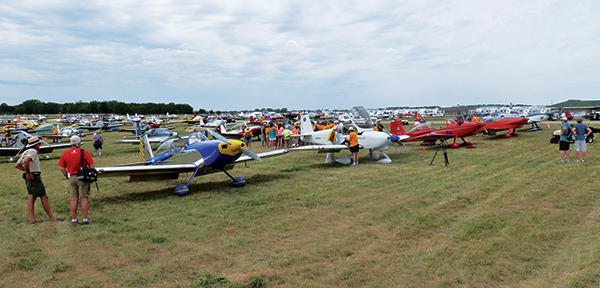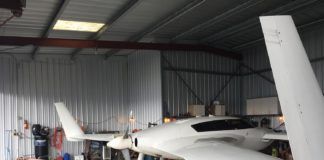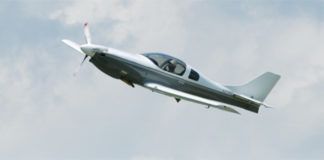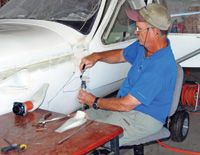Spring is here (or will be when you read this) and with it comes the “flying season”—at least for those in the northern climes whose hangar doors have been frozen shut for several months. Of course, those who live in places where the seasons never change have been burning everyone else’s share of avgas all winter long. But statistically, spring is when pilots start shaking off the rust and getting out more—and that means going to fly-ins and the big shows to mingle with others of their kind, as well as the general public. Sometimes the destination isn’t a formal event, just a bunch of different airplanes converging on a favorite lunch spot or fly-in breakfast. But either way, it is not uncommon for those on the other side of the airport fence to be interested in our planes, and this gives us an opportunity to share aviation with those who may very well become our future.
The big shows, like Sun ‘n Fun or AirVenture, are a great place for people to mingle with airplanes. This is, admittedly, both good and bad. First, the good: We have all seen the fascinated stare in a young child’s eyes as they look at the gleaming airplane and see the handsome pilot who has recently stared death in the face while dogfighting with the clouds. Seriously, though, many of them just have that fascination with airplanes that makes them want to reach out and touch them. And equally seriously, this is a golden moment to grow our community—by giving them a chance to have a friendly and fascinating interaction with something that could take over their lives and set them on a path to the sky. However, there is a bad: reaching children with clueless parents who indulge their kid’s wishes to make footprints on the wings of the nearest airplane, hang on props, or kick away at wheelpants to see if they are solid.
Public events are a double-edge sword for aviation—a great way to bring in the new, yet possibly dangerous to people already involved. The important thing is that we have control over how we react to, and interact with, that public. I have met many a homebuilder who says, “I will never go to a public fly-in event again. The last time, I had to yell at those little kids who wanted to touch my airplane and get them back behind the ropes or the fence!” OK, I understand that need to protect the airplane. But let’s put ourselves into the mind of that kid. We have been taken by our parents to see something that they tell us will be really neat. We see bright, shiny, inviting things, and we reach out to touch them—only to be yelled at and threatened by a complete stranger—an adult stranger who makes us feel really bad. The young mind associates punishment, abuse, and embarrassment with aviation, and we have lost that person to our community forever.
Certainly, our airplanes need to be protected, and if you find yourself at a crowded field with a reaching public, you have two choices: Stay with your plane and interact with the crowds in a way that answers their questions, gives them safe access, and has them leaving with a positive experience. Or get in the airplane and leave so that you don’t have to interact. Either works to protect your airplane, and frankly, leaving might be better for our community than interacting in a negative way. Some of us just aren’t people persons—and that’s OK, so long as we recognize it. But let’s face it—every indication is that the pilot population is shrinking, there are few new starts, and we are aging rapidly out of the cockpit. We need to grow this community, not shrink it by turning people away. Yes, part of the allure of aviation is its exclusivity, but we will go extinct if we don’t let new blood into the game.
We need to be encouraging, welcoming, and nurturing when it comes to those interested in joining this remarkable community of aviation. Homebuilders play a big part in being ambassadors for the breed. Let’s face it—we have cool airplanes, and we love to show off our work! The key is to show them off not just to community members, but to those who will respectfully enjoy them regardless of who they are. Respect is a two way street, so take the time to show them how to treat your airplane, and hopefully they will respect what you have built. A friendly interaction makes a far better memory than a cold shoulder or a reprimand.
By the way, does your airplane have a business card? It is so easy and inexpensive to have picture cards made up these days, why not give it a thought? Just find a nice picture of your plane, add a little contact information, and carry a handful in a pocket. Hand them out to those interested, and if they have further questions or interest, they can get in touch with you.
(Oh—the key to good behavior by children is in their parents’ hands. Most kids are wide-eyed sponges, willing and waiting to learn. They don’t know how to behave, so they follow their elders’ lead. If you see a kid behaving badly, don’t just yell at them; interact with the parents, and get them to keep the kids under control. It’s often the parents who have encouraged the bad behavior in the first place, so reprimand the responsible party.)
Let’s encourage new starts—not make aviation unfriendly and unwelcoming. We don’t want to be the last generation that knows the joy and excitement of personal aviation. We have a responsibility to the future to turn the sparkle in a child’s eye into a set of wings and the rapture of flight.
Respect Each Other
Oh yes—while we’re on the topic of airshows and fly-ins, here’s something to remember about helping out your fellow aviators. When someone lands and taxies in at a fly-in event, it is not uncommon for them to have a crowd gather outside the airplane even before they shut down. I can’t tell you how many times I have taxied to a tie-down and then had the greeter try and talk to me through the closed canopy while I am still trying to shut down the avionics and record the flight time on my kneeboard or airplane log. Usually, they are saying, “Welcome to the show!” But that welcome is lost in the distraction. Other times, it is just a friend who recognizes the airplane and wants to say hi before everyone else. Distractions such as a premature greeting disrupt a pilot’s flow and can cause them to miss something—like accidently leaving the mags hot, or forgetting the master switch.
Do your friends a favor—leave them alone until they open the cockpit door or canopy, take off their headset, and give you a welcoming shout. It only takes an extra minute to let them wind down from the flight, go through their normal procedures, and be ready to greet the world.

![]()
Paul Dye retired as a Lead Flight Director for NASA’s Human Space Flight program, with 40 years of aerospace experience on everything from Cubs to the space shuttle. An avid homebuilder, he began flying and working on airplanes as a teen, and has experience with a wide range of construction techniques and materials. He flies an RV-8 that he built in 2005, and an RV-3 that he built with his pilot wife. Currently, they are building a Xenos motorglider. A commercially licensed pilot, Paul has logged over 4800 hours in many different types of aircraft and is an EAA tech counselor, flight advisor, and member of the Homebuilder’s Council. He consults and collaborates in aerospace operations and flight-testing projects across the country.






Mr. Dye, I am a retired educator and a long time pilot wannabe. My interest is ultralights. Although, now, probably too old to fly my own plane, I remember becoming aware of Oshkosh through a magazine I read in the mid 80s. I have been hooked since. I attended Fun n Sun when I lived and worked in Florida and I wondered if a special section could be set aside for those who learn by touching. There may be risks. But, are pilots in the business of mitigating risks so they can feel the joy of flying? Is there a way some of that feeling be shared with possible future pilots? I wish you a great year in flying.
I was the docent of a museum dedicated to the Emigh Trojan.
I was having pictures with kids in the plane when a pilot came in and told them to stop, I tried to calm him down but he just got louder in a room full of people.
Why are some people so blind.